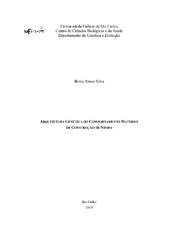| dc.contributor.author | Silva, Bruno Sauce | |
| dc.date.accessioned | 2016-06-02T20:21:24Z | |
| dc.date.available | 2010-10-19 | |
| dc.date.available | 2016-06-02T20:21:24Z | |
| dc.date.issued | 2010-08-05 | |
| dc.identifier.citation | SILVA, Bruno Sauce. Arquitetura genética do comportamento materno de construção de ninho. 2010. 77 f. Dissertação (Mestrado em Ciências Biológicas) - Universidade Federal de São Carlos, São Carlos, 2010. | por |
| dc.identifier.uri | https://repositorio.ufscar.br/handle/ufscar/5475 | |
| dc.description.abstract | Genetic architecture of a phenotype represents the total number of genes, independent effects (additivity), the interactions between alleles (dominance and epistasis), and its effects on other phenotypes (pleiotropy). An enormous debate about general types of genetic architectures relates the importance of independent and interactive variation in the adaptive process. Because natural selection reduces additive variation, we expect, of fitness related phenotypes, lesser additive than interactive variation and relatively more genes with moderate effects. Maternal care is a phenotype with enormous importance to fitness. Of the maternal care behaviors, the nest building highlights itself improving pups survival by protection against predators and temperature maintenance. We investigated the genetic architecture of nest building in mice and tested the hypothesis that this behavior has a genetic architecture related to fitness, also verifying possible associations with anxiety and weight. For that, we checked the relation between all phenotypes and tested, using the QTL analysis, the phenotypic association with regions (microsatellites markers) spread about all genome of F2 females at maternal stage from the intercross of inbred strains SM/J and LG/J. We found 23 QTLs which, individually, are associated with phenotypic variation on nest building, weight and anxiety (15 QTLs at the 6 nest building phenotypes). The nest building s individual QTLs have moderate effects (from 4 to 13%), and the numerous epistatic QTLs add to increase this explained variation. There are common regions for nest building with anxiety and weight and, searching for candidate genes, we found genes with effects already described for these phenotypes. Hence, we corroborate our hypothesis of the genetic architecture type related to fitness for nest building behavior, of genes with bigger effects and high interactive variation. The identification of regions associated with maternal care in mice and the knowledge of the related genetic architecture can help in identifying genes for these behaviors in other mammals, and in the comprehension of general patterns in adaptive process and life evolution. | eng |
| dc.description.sponsorship | Universidade Federal de Minas Gerais | |
| dc.format | application/pdf | por |
| dc.language | por | por |
| dc.publisher | Universidade Federal de São Carlos | por |
| dc.rights | Acesso Aberto | por |
| dc.subject | Genética quantitativa | por |
| dc.subject | QTL | por |
| dc.subject | Genética do comportamento | por |
| dc.subject | Camundongos - ninhos | por |
| dc.subject | Arquitetura genética | por |
| dc.subject | Comportamento materno | por |
| dc.subject | Construção de ninho | por |
| dc.subject | Genetic architecture | eng |
| dc.subject | QTL | eng |
| dc.subject | Maternal Behavior | eng |
| dc.subject | Behavior | eng |
| dc.subject | Nest building | eng |
| dc.subject | Mouse | eng |
| dc.title | Arquitetura genética do comportamento materno de construção de ninho | por |
| dc.type | Dissertação | por |
| dc.contributor.advisor1 | Peripato, Andréa Cristina | |
| dc.contributor.advisor1Lattes | http://lattes.cnpq.br/0657713343451089 | por |
| dc.description.resumo | Arquitetura genética de um fenótipo representa o número total de genes, os efeitos independentes (aditividade), as interações entre alelos (dominância e epistasia), e o efeito destes em outros fenótipos (pleiotropia). Um grande debate entre tipos gerais de arquitetura genética está no papel da variação independente e de interações no processo adaptativo. Pela seleção natural reduzir a variação aditiva, esperamos de fenótipos ligados ao fitness menor variação aditiva relativa a variação de interações e genes com efeitos médios relativamente mais comuns. O cuidado materno é um fenótipo com grande importância para o fitness. Dentre os comportamentos de cuidado materno, a construção de ninho destaca-se aumentando a sobrevivência dos filhotes pela proteção contra predadores e manutenção da temperatura. Investigamos a arquitetura genética da construção de ninho em camundongos e testamos a hipótese que esse comportamento tem a arquitetura genética relacionada ao fitness, verificando também possíveis associações com ansiedade e peso. Para isso, checamos as relações entre os fenótipos e testamos, com a análise de QTL, a associação dos fenótipos com regiões (marcadores microssatélites) por todo o genoma de fêmeas F2 em fase materna do intercruzamento das linhagens endogâmicas SM/J e LG/J. Obtivemos 23 QTLs que, individualmente, estão associados com a variação nos fenótipos de construção de ninho, peso e ansiedade (15 QTLs para os 6 fenótipos de construção de ninho). Os QTLs individuais de construção de ninho têm efeitos moderados (de 4 a 13%), e os muitos QTLs epistáticos colaboram aumentando essa variação explicada. Existem regiões em comum para ninho com peso e ansiedade e, na procura de genes candidatos, descobrimos genes já descritos com efeitos nesses fenótipos. Assim, corroboramos a hipótese do tipo de arquitetura genética relacionada ao fitness para o comportamento de construção de ninho, de genes com grandes efeitos e alta variação genética de interações. A identificação de regiões associadas ao cuidado materno em camundongos e o entendimento da arquitetura genética envolvida poderão contribuir na identificação de genes para esses comportamentos em outros mamíferos, e na compreensão do padrão geral do processo adaptativo e da evolução dos seres vivos. | por |
| dc.publisher.country | BR | por |
| dc.publisher.initials | UFSCar | por |
| dc.publisher.program | Programa de Pós-Graduação em Genética Evolutiva e Biologia Molecular - PPGGEv | por |
| dc.subject.cnpq | CIENCIAS BIOLOGICAS::ECOLOGIA | por |
| dc.contributor.authorlattes | http://lattes.cnpq.br/3437905516191475 | por |
